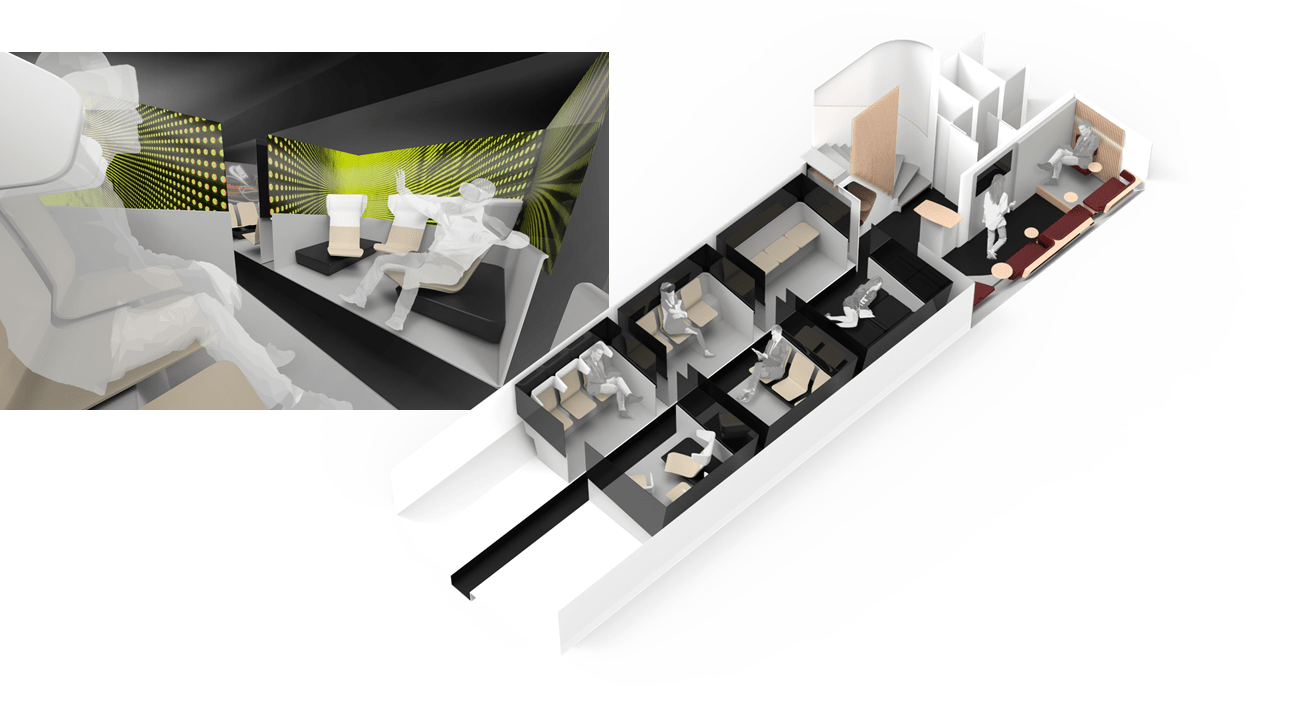Convincing people to fly again will require cleaner, less dense, and more “contactless” cabins
Jaime Moreno
CEO

Lower deck concept co-created by Mormedi as part of the Future Cabin for the Asian Market projec
What’s the current situation?
According to Moody’s, global airline capacity may fall up to 35% in 2020 due to the effects of the coronavirus.
When we look for reference points to compare with, there is little that can equal the current crisis. This crisis is orders of magnitude more devastating than the SARS outbreak of 2003. SARS affected the industry for a period of six months and was geographically rather limited, with almost 90% of the 8,096 total cases confined to China and Hong Kong. Unfortunately, this health crisis has spread all over the world, and will cause the airline industry to feel its effects for a much longer period.
What actions is the industry taking?
Airlines are already responding to this dramatic situation. Lufthansa announced last week that will retire 42 aircraft from its fleet, including six A-380s. With this reduction Lufthansa is reducing its future capacity by 20%. AIG also has cut its capacity temporarily by 90%. IATA has announced that airlines will likely be unable to reimburse the money for flights that will not operate due to a lack of liquidity.
Travel restrictions will probably continue until the end of 2020 in many regions. Countries will have new immigration policies regarding healthcare and stricter border controls.
How will this affect the industry?
With this situation I am afraid that the future of many airlines will be compromised; especially low-cost airlines. Airlines are coming under strong financial stress already and we are going to see many bankruptcies soon, as well as a spate of mergers & acquisitions within the next 6 months.
I believe that leisure travel is going to be more affected than business travel for at least the next 6-12 months, and it is going to take us at least a few years to return to the same numbers of passengers flying as we had before the COVID-19 crisis.
That is not to say that business travel will bounce back quickly. This crisis has caused the majority of businesses to accelerate their digital transformation and teleworking efforts, teaching companies the power of—and potential cost savings afforded by—tools like Zoom, Teams, and Webex, which will surely be in much greater use even after this crisis is over.
The OEMs, led by Airbus & Boeing, will also be tremendously affected. In my conversations with cabin interior suppliers, I hear that they are expecting a decrease in demand for new aircrafts of 30% over the coming years. We will probably see many aircraft orders cancelled or postponed. In fact, the low price of fuel will erode the rationale for efficiency savings enabled by newer aircrafts, such us the A350 and the B787, and many airlines will choose to maintain their older fleets.
What will change?
COVID-19 is going to change the world as we know it. The lockdown in place in many countries is going to provoke a change in consumer habits and a fundamental shift in values. Passengers that will travel in the future will care more about the cleanliness of the aircraft, privacy, and seat density. It could be reasonable to assume that the economic drivers that this industry has being dealing with over the last few decades will no longer be as valid. Many airlines will have to adapt their products to new requirements and travelling will become more selective and more expensive, much as it was 20 years ago.
I think there is going to be a lot of space for innovation. Airlines that are able to adapt quickly to this new environment will survive and will get out of this crisis in a stronger competitive position.
Airlines will have to review all their processes to become more efficient, like reviewing their cleaning processes to guarantee the health of the passengers (especially around the touch screens, dining tables, arm rests, etc.). Maybe reviewing the health of their passengers and cabin crew before boarding will become a new standard, in order to guarantee the health and safety of everyone onboard.
Airlines will also have to review how they go about their customer segmentation and look into customer preferences, as I am quite sure after this crisis preferences will have changed, and this will have an impact on cabin layouts & LOPAs.
Inside the cabin, we are going to see an acceleration in the roll out of newer interfaces such as voice control (versus touch screens), as well as CMF that will be determined not only by aesthetics but also by antibacterial function.
A time for renewal
In conclusion, airlines will have to review the whole passenger experience and reconsider the entire user journey, as many touch points will have to be redesigned to adapt to our new circumstances and way of travelling.
Isn’t it likely that many passengers would pay extra for extra space and peace of mind—like not having anyone sitting next to them—when travelling in a sealed cabin?
The way we will travel in the future will be much different than it has been up to now, and hopefully, in a lot of ways, for the better.
This article originally appeared in Aircraft Interiors International.
If you would like to learn about how Mormedi can help your company innovate in transportation and mobility, contact us at madridHQ[at]mormedi.com.


